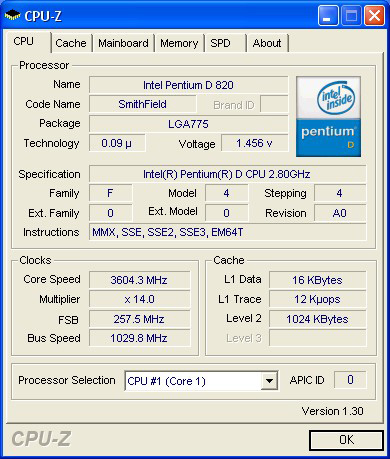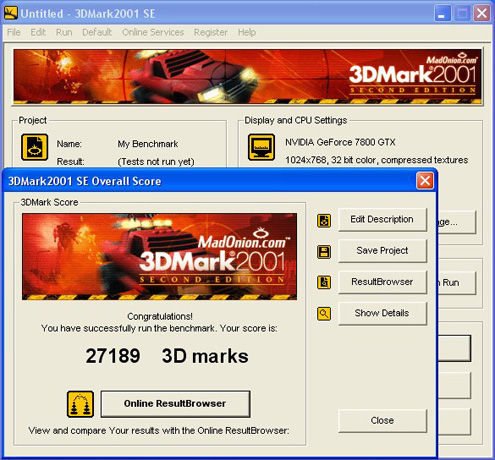Intel 945P Motherboards: Going from Hopeless to Enthusiastic
by Gary Key on November 15, 2005 12:02 AM EST- Posted in
- Motherboards
EPOX 5LDA+GLI: Overclocking
FSB Overclocking Results
Memory Stress Tests
Memory stress tests look at the ability of the Epox 5LDA+GLI to operate at the officially supported memory frequencies of 667MHz DDR2 at the best performing memory timings that the Corsair CM2X512A-5400UL revision 1.3 will support.
The Epox 5LDA+GLI was completely stable with 2 DDR2 modules in Dual-Channel at the settings of 3-2-2-8 at 2.1V.
We will now install all four available memory slots, which are usually more strenuous on the memory subsystem than testing 2 DDR2 modules on a motherboard.
The Epox 5LDA+GLI was completely stable with 4 DDR2 modules in Dual-Channel at the settings of 3-4-4-8 and needed the voltage increased to 2.15V. This is a very good accomplishment for a board targeted at the mainstream market.
FSB Overclocking Results
| Front Side Bus Overclocking Testbed | |
| Processor: | Pentium 4 Prescott LGA 775 820 Dual Core 2.8GHz |
| CPU Voltage: | 1.4500V (1.3000V default) |
| Memory Settings: | 3-2-2-8 at 667MHz |
| Memory Voltage: | 2.15V |
| NorthBridge Voltage: | 1.60V |
| SouthBridge Voltage: | 1.00V |
| Cooling: | Intel 840EE Heat Sink |
| Power Supply: | OCZ Power Stream 520 |
| Maximum CPU OverClock: | 257fsb x 14 (3598MHz) +28% |


Memory Stress Tests
Memory stress tests look at the ability of the Epox 5LDA+GLI to operate at the officially supported memory frequencies of 667MHz DDR2 at the best performing memory timings that the Corsair CM2X512A-5400UL revision 1.3 will support.
| Epox 5LDA+GLI Stable DDR667 Timings - 2 DIMMs (2/4 slots populated - 1 Dual-Channel Bank) |
|
| Clock Speed: | 200MHz (800FSB) |
| Timing Mode: | 667MHz - Default |
| CAS Latency: | 3 |
| RAS to CAS Delay: | 2 |
| RAS Precharge: | 2 |
| RAS Cycle Time: | 8 |
| Voltage: | 2.1V |
The Epox 5LDA+GLI was completely stable with 2 DDR2 modules in Dual-Channel at the settings of 3-2-2-8 at 2.1V.
We will now install all four available memory slots, which are usually more strenuous on the memory subsystem than testing 2 DDR2 modules on a motherboard.
| Epox 5LDA+GLI Stable DDR667 Timings - 4 DIMMs (4/4 slots populated - 2 Dual-Channel Banks) |
|
| Clock Speed: | 200MHz (800FSB) |
| Timing Mode: | 667MHz - Default |
| CAS Latency: | 3 |
| RAS to CAS Delay: | 4 |
| RAS Precharge: | 4 |
| RAS Cycle Time: | 8 |
| Voltage: | 2.15V |
The Epox 5LDA+GLI was completely stable with 4 DDR2 modules in Dual-Channel at the settings of 3-4-4-8 and needed the voltage increased to 2.15V. This is a very good accomplishment for a board targeted at the mainstream market.










26 Comments
View All Comments
Houdani - Tuesday, November 15, 2005 - link
The other reviewers here at Anandtech offer their own style, thereby providing the "mix it up" factor. I personally don't think you need to adjust your style, as I happen to like the cultural infusion supplied by your literary quotes.Furen - Tuesday, November 15, 2005 - link
Fair enough, I was just giving my personal opinion on the matter.bersl2 - Tuesday, November 15, 2005 - link
What's wrong with being exposed to what the author believes to be wisdom? Surely you don't read these articles simply for the technical specifications; otherwise, you would read the spec sheet. Why, then, do you object to the author trying to relate an idea to you?Furen - Tuesday, November 15, 2005 - link
I read the articles for their technical merits. Spec sheets do not show how the different components interact with one another nor can they show performance, stability, etc; and, most importantly of all, they're made by the manufacturer, who is hardly to be considered an unbiased source. The problem with throwing a strong idea in front of the reader before giving him article is that this idea becomes the filter through which the rest of the article is viewed. This is, of course, very effective if you are trying to persuade the user to reach the same conclusions as you, but it skews the reader's ability to analize the purely technical merits of the products.mbhame - Tuesday, November 15, 2005 - link
What makes you so sure Conroe is the last P4? ;)JarredWalton - Tuesday, November 15, 2005 - link
Conroe isn't a P4. It's the next generation architecture that Intel has not yet named - also referred to as the NGATIHNYN. :p